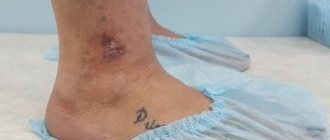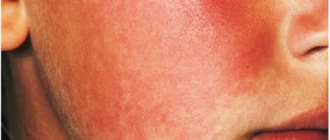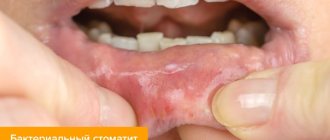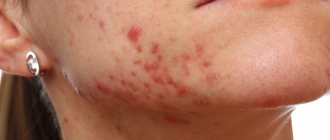An acute inflammatory process, which, usually starting from the labia minora or majora, gradually spreads to the clitoris and vagina, is called vulvitis in medical practice. This pathological condition is accompanied by acute symptoms, which can manifest in the fair sex, regardless of age.
Vulvitis requires immediate consultation with a specialist, as it can lead to adhesions in the mucous membranes of the external genitalia, which subsequently causes serious problems in the intimate area, and in the case of the disease in young women, becomes a cause of infertility.
Causes
There are 11 main factors that cause erosions on the female genitalia. These conditions are associated with health characteristics, the presence of hidden inflammatory processes in the body, intolerance to certain substances, and mechanical damage to the skin. Some factors can only be determined based on diagnostic results. Therefore, the patient will have to undergo laboratory, hardware, and sometimes instrumental types of examination. Ulcers on the labia are not congenital anomalies; they occur throughout life.
Thrush
The official term that identifies this pathology is “vaginal candidiasis.” Women with weakened immune systems, diabetes mellitus, and intestinal dysbiosis are susceptible to the disease. Thrush also develops due to prolonged use of antibiotics and insufficient hygiene procedures. In addition to ulcers on the labia, the disease is characterized by:
- abundant production of curdled secretion with a fishy odor
- intense itching
- swelling, redness of the vulvar mucosa
- pain when urinating, during intimacy
The disease can be easily eliminated; after eliminating the pathogenic microflora, new ulcers on the genitals do not appear. But at the same time as undergoing treatment, you need to avoid eating sweets: glycogen creates a favorable condition for the activity of fungal microflora.
Vulvar dysplasia
It is a precancerous condition and, when detected at the initial stage of development, can be easily eliminated. Causes of vulvar dysplasia: hereditary predisposition to tumor processes, chronic colpitis or bartholinitis, infection with the human papillomavirus. Symptoms of the pathology, in addition to the appearance of ulcers on the labia: tissue swelling, itching, vaginal secretion, increased dryness in the vagina.
The absence of pronounced signs in the initial stages of the disease is an explanation for the late seeking of medical help. Treatment of women with dysplasia involves ablation of the vulva with a laser beam or liquid nitrogen. According to indications, surgical intervention is performed - step-by-step excision of tissues changed by the pathological process.
Choose a specialist, read reviews and make an appointment with a gynecologist online
Allergic reaction
Ulcers on the labia occur due to intolerance to pads and vaginal tampons, detergents; latex from which condoms are made. Wounds on the genital mucosa can occur in response to irritation from ejaculate on the vulva. This happens due to the characteristics of the immune system if a woman has developed sperm intolerance, which occurs in 1 case out of 10 thousand.
In addition to erosions, allergies cause severe itching, burning in the vagina, and redness of the tissues. The severity of your health can reach a high level. Providing medical care begins with stopping contact of the irritant with the tissues of the vulva.
Genital herpes
The disease is caused by the herpes virus, which affects the mucous membrane of the vulva and provokes a number of symptoms.
Among them:
- The formation of multiple bubbles, grouped, filled with cloudy contents. When these new growths are opened, a burning sensation, pain occurs, and soon ulcers form in the areas where the crusts come together.
- Itching in the vagina.
- Redness of the tissues of the vulva.
- Slight increase in body temperature.
The reasons for the development of genital herpes are unprotected intimacy with an infected partner. The virus can also enter the genitourinary system during diagnostic and treatment procedures. For example, if staff used unsterile instruments. In rare cases, the infectious process begins after visiting public toilets without using special pads. Genital herpes is treatable, but treatment usually takes more than 3 weeks. It is important not to interrupt therapy at the first signs of relief.
Syphilis
A disease that occurs as a result of infection during intimacy. Pathogenic microflora - Treponema pallidum, provokes a number of severe changes in the body. The period from the moment the pathogen enters the bloodstream until the appearance of primary symptoms takes from several days to 6 weeks. The development of pathology is preceded by intimate intimacy with a partner who suffers from syphilis. Less commonly, infection occurs through household contact or through blood.
Symptoms of the condition:
- Pain during intimacy
- Production of large amounts of vaginal secretion
- Frequent urination
- Formation of ulcers on the labia with a red dense border
- Feeling of incomplete emptying of the bladder
Syphilis is one of the pathologies with a severe type of progression, since internal organs are susceptible to damage. Elimination of the disease takes from 1 to several months, which once again emphasizes the importance of preventing the development of this disease.
Vulvovaginitis
The disease is a lesion of the genitals and vaginal tissues. The causes of the pathology are varied: from insufficient body hygiene to helminthiasis and rubbing of the skin with underwear. The condition is accompanied by the appearance of small ulcers and oblong erosions on the inner surface of the labia. Additionally, the following symptoms occur: itching in the vagina, pain, burning when urinating and while walking. Vulvovaginitis often takes a chronic form. With the right therapeutic approach, it can be easily eliminated.
Leukoplakia
The pathology refers to precancerous conditions and is often combined with cervical dysplasia. If leukoplakia is not addressed in a timely manner, the process becomes carcinogenic. The causes of the pathology are a previous cauterization procedure of the cervix, hereditary predisposition, work in conditions of increased harmfulness. Since the process has an asymptomatic period, for a long time the woman is not aware of the development of leukoplakia. The condition is characterized by the formation of white or light gray ulcers with clear boundaries on the inner part of the labia. During the inspection, it is not possible to remove the surface of the erosions with a spatula.
Additional signs of leukoplakia:
- Burning and itching that occurs even at rest as the disease progresses
- Decreased sensitivity of the vulva
- Intense pain during intimacy
- Increased body temperature
- State of intoxication
Women over 40 years old, with altered hormonal levels, weak immunity, and a history of sexually transmitted infections are susceptible to the development of the pathology.
Trichomoniasis
A disease that is transmitted during intimacy. The period from the moment a pathogenic microorganism enters the urogenital tract until the first signs appear takes from several days to 2 months. This indicator depends on many factors, including the state of the immune system. Signs of trichomoniasis, except for erosions on the vulva:
- Pain during intimacy
- Periodic increase in body temperature to low numbers
- Intense itching in the vagina
- Vaginal secretion is foamy, green in color, with an unpleasant odor
- Menstrual irregularities
If detected early, the pathology can be easily eliminated. Simultaneously with the woman's treatment, her partner undergoes therapy.
Lichen planus
Not all clinical cases of erosion on the vulva are associated with sexually transmitted infections. Somewhat less frequently, the root cause of the defect is associated with dermatological pathologies. The cause of the development of lichen planus is diabetes mellitus, regular mechanical damage to tissue (scratching, rubbing), and a hereditary factor.
The risk of infection increases if your immune system is weakened. This happens due to hypothermia, intoxication, stress, fasting, lack of sleep, and chronic diseases. Lichen planus progresses with periods of attacks and remission. The goal of treatment is to strengthen the body’s protective properties, which serves to prevent exacerbation of the pathological process.
Pyoderma
A disease caused by infection with staphylococci and streptococci. A favorable environment for the development of pyoderma is insufficient intimate hygiene, poor quality of hair removal (cuts, skin irritation). From the moment pathogenic microflora enters the wound until the first signs appear, it takes from several hours to 3-5 days. The pathology is characterized by the formation of ulcers, increased body temperature, enlarged lymph nodes, weakness, and decreased ability to work. Pyoderma significantly aggravates your well-being and often requires microsurgical intervention.
Scabies
A parasitic disease develops due to scabies mites coming into contact with the skin. The primary symptoms of the pathology occur 4-6 hours after infection with the pathogen. The predominant route of scabies disease is through contact and household contact.
Signs of an infectious process:
- Intense itching in the vulva that does not bring relief
- General intoxication of the body
- Burning and pain in the urogenital tract, aggravated during urination
- Insomnia, irritability and other symptoms caused by lack of proper rest
To eliminate the disease, external treatment of inflamed tissue is indicated. Treatment (skin treatment) is carried out in the evening, which is explained by the increased activity of the scabies mite at this time of day. Hygienic procedures can be carried out only on the condition that the drug will be on the pathogenic focus for at least 12 hours in a row. At the end of the therapeutic course, a change of underwear and bed linen is indicated.
Causes of inflammation of the clitoris and labia
Most often, the pathology is of an infectious-inflammatory nature. Depending on the cause of the development of vulvitis, there are two main forms of the disease.
- Primary vulvitis. This inflammation is somewhat less common than secondary inflammation, and usually affects either patients of a younger age category or women in the postmenopausal period. The cause of the development of primary inflammation of the labia and clitoris is the following factors: failure to comply with the rules of personal hygiene, too tight synthetic underwear, allergic reactions to shower gel or other hygiene products, mechanical damage to the external genitalia and hormonal imbalances. Little girls may experience similar inflammation if they have helminthiasis - infestation with worms.
- Secondary vulvitis . The most common form of inflammatory processes of the clitoris and labia resulting from infectious infection. Nonspecific pathogens of vulvitis include all representatives of opportunistic flora, which are normally natural inhabitants of female microflora - Escherichia coli, staphylococci, streptococci, yeasts, etc. Specific infections include sexually transmitted infections. Secondary vulvitis occurs more often in young patients of childbearing age, as they are sexually active.
Possible complications
If, even after the appearance of wounds on the surface of the genitals, a woman does not perform hygiene procedures, pathogenic microflora enters the resulting ulcers. In this case, a secondary infection develops and the inflammatory process progresses. Vulvitis is manifested by increased body temperature, severe pain in the genitals, swelling of the labia, and redness of the tissues. Due to intense discomfort, it is painful for a woman to urinate, walk, or sit.
Vulvitis is eliminated through antibacterial treatment, physiotherapeutic techniques, and application of compresses with anti-inflammatory drugs. Since the formation of ulcers on the labia is caused by viral and/or sexually transmitted diseases, secondary infertility may develop. This happens due to the lack of timely therapy.
Symptoms
When such rashes appear, women often present other complaints. These include:
- pain and discomfort in the pelvic and genital areas;
- feeling of itching;
- burning during urination;
- enlargement of regional lymph nodes;
- change in the amount and color of vaginal discharge;
- decreased libido;
- disruptions of the menstrual cycle;
- discomfort during sexual intercourse.
Diagnostics
To identify the cause of the formation of ulcers on the genitals, a woman undergoes:
- Survey
- Examination on a gynecological chair
- Laboratory testing of blood and urine
- Smear to determine vaginal microflora
- Ultrasound of the uterus, appendages
- Determination of blood glucose levels
- Analysis for the presence of tumor markers in the body
- PCR diagnostics
If the development of a precancerous condition is suspected, the woman is prescribed a biopsy of the ulceration particle and a histological analysis of the material taken. The range of necessary studies depends on the individual characteristics of the clinical case. There is no single diagnostic program that would suit absolutely all patients.
Diagnosis and treatment of inflammation of the external genitalia
The diagnosis can only be made by a gynecologist. At the same time, no special diagnostics are needed at the first stage. The doctor will immediately notice inflammation during a routine gynecological examination. Next, the doctor determines the cause of the inflammation, after which a treatment regimen is selected.
Depending on the cause of the development of the pathology - an allergic factor, injury, incorrectly selected underwear - it is enough to simply limit the direct contact of the provoking agent with the organs and apply symptomatic therapy (local treatment that relieves unpleasant symptoms). You can easily identify this cause by donating blood for allergies. The analysis will show the cause due to the presence in the blood of special antibodies that are formed only during allergic reactions.
When diagnosing the infectious nature of the disease, microbiological culture is carried out on nutrient media in order to identify the causative agent and the correct selection of antibiotic therapy. To do this, the gynecologist takes swabs from the genital tract and sends them to the laboratory.
There, they first determine the type of infection, and then test different drugs on the samples. Since almost all pathogens of sexual diseases easily adapt to medications, choosing pills that will help you completely recover is not easy. Sometimes specialists go through up to a dozen different medications.
Unfortunately, inflammation is rarely caused by a single pathogen; more often, the cause is a whole bunch of infections, starting with thrush and ending with gonorrhea. In such cases, it will not be enough to simply take smears - the examination will continue further. You will have to donate blood for syphilis, hepatitis and undergo a pelvic ultrasound, as the process quickly spreads through the genital tract, affecting internal organs.
Treatment
In 90% of cases, a woman is indicated for hospitalization in a hospital department - for continuous monitoring of her condition and assessment of the effectiveness of the treatment. In case of infectious and inflammatory processes, it is necessary to undergo antibacterial therapy. Antibiotics are administered intramuscularly for 5-7 days, then switch to the oral form of using drugs from this group. Since antibacterial therapy can provoke a disruption of the intestinal microflora, Linex, Nystatin or their analogues must be taken at the same time. This action will avoid the development of dysbiosis and digestive problems.
To treat a defect that occurs on the genital mucosa, antiseptic solutions are used - Miramistin, Chlorhexidine or their analogues. If erosion is caused by an allergic reaction, antihistamines are administered: Diazolin, Suprastin, Tavegil. If there is a relationship between the appearance of ulcers on the genitals and a viral infection, medications are prescribed that suppress pathogenic microflora and increase immunity. The most effective option in this regard is Cycloferon.
Additionally, to strengthen the body's protective properties, it is recommended to introduce vitamin complexes - Milgamma, Neurorubin, Neurobex. It is not recommended to avoid water procedures during treatment. But when drying the skin of the affected area, the actions should be performed with blotting movements, without rubbing it.
Review of drugs for the treatment of intimate wounds
For bacterial, viral and fungal diseases, both partners are treated. In order to avoid negative consequences and complications during therapy, it is necessary to abstain from sexual intercourse and maintain hygiene of intimate organs.
Treatment is complex and includes taking local medications: ointments, gels, suppositories.
| Pharmacological group | Features of the drugs, for the treatment of which wounds they are used | Examples of drugs |
| Antibacterial | Treatment of intimate wounds due to infections caused by bacteria. | Levomekol, Baneocin, Tetracycline ointment |
| Antimycotic | Therapy for thrush, medications for fungi of the Candida variety | Fluconazole, Clotrimazole |
| Antihistamines | Treatment of mucous membranes in the intimate area resulting from allergies. | Suprastin, Zodak, Fenistil |
| Antiviral | Treatment of wounds due to viral diseases (herpes) | Acyclovir, Viferon, Interferon |
| Nonsteroidal anti-inflammatory drugs | Reducing pain from itching, burning, and discomfort. The products temporarily relieve pain, swelling and inflammation. | Diclofenac, Ibuprofen |
Review of healing ointments:
- Solcoseryl is a medicine based on the blood of calves obtained by hemodialysis. The healing process of damage in intimate areas is accelerated by stimulating collagen production and improving glucose transport into metabolically depleted cells and tissues. The medicine is available in the form of a gel, ointment and solution for injection. The gel is used for rapid granulation and release of purulent contents from the wound. The ointment is used when the damaged area dries out.
- Levomekol - effectively treats wounds on the head of the penis, and is also used after gynecological operations. The ointment is effective in the treatment of infected ulcers; it contains an antibiotic. Active components of the drug: methyluracil and chloramphenicol. The first ingredient improves cellular nutrition and accelerates skin regeneration, the second is active against gram-positive and gram-negative bacteria.
- Protact - cream will help with minor damage and cracks, relieves minor redness and irritation. A protective antimicrobial film is formed on the surface of the skin, providing the necessary hydration to intimate, delicate areas.
- Pantestin is a medicine based on the active components dexpanthenol and miramistin. When the gel comes into contact with the skin, it changes its chemical composition: dexpanthenol is converted into pantothenic acid. Wound healing is accelerated and skin regeneration is ensured. The drug acts locally and is not absorbed into the systemic circulation.
- Rescuer - the drug is effective for deep and superficial damage to intimate areas. Regenerating and antibacterial properties are provided, the medication helps with purulent wounds.
- Argosulfan is a complex drug that has antibacterial and analgesic effects. The hydrophilic base of the cream helps maintain an optimal level of moisture on damaged skin.
The ointments are easy to use and can be used at home. Directions for use: Apply a thin layer to the damaged surface.
The drugs have contraindications and age restrictions for use. During pregnancy and lactation, treatment is carried out after consultation with a doctor.
Prevention
To prevent the development of diseases that are accompanied by the appearance of ulcers on the labia, it is necessary:
- Carry out intimate hygiene thoroughly and promptly using hypoallergenic products
- Avoid unprotected intimate relationships with unfamiliar partners
- Avoid hypothermia
- Avoid excessive use of pads (especially scented ones)
- Maintain intestinal microflora at normal levels
- Avoid wearing overly tight underwear
Additional preventive measures are to abandon the uncontrolled use of antibiotics, avoid stress, and undergo seasonal vitamin therapy. With a high probability of developing diseases that manifest themselves as erosions on the genitals, it is possible to avoid.
Ulcers on the labia are one of the basic signs of sexually transmitted diseases. In more rare cases, the formation of a defect relates to manifestations of allergies, skin or other disorders. Disorders that lead to the formation of erosions on the genitals can be easily eliminated. To normalize well-being, it is necessary to undergo comprehensive treatment. Before visiting a doctor, it is not recommended to take medications or use various methods to treat the defect that has appeared.
Types of gynecological abscesses
Gynecological abscess is classified according to several criteria. Firstly, purulent capsules are divided according to the nature of their formation:
- acute purulent process - develops rapidly, symptoms quickly intensify, and the patient’s general well-being worsens;
- chronic abscess - practically not accompanied by symptoms, characterized by frequent relapses of suppuration and the formation of fistulas at the site of the purulent cavity.
Secondly, the disease is classified according to the place of formation of ulcers:
- bartholinitis or abscess of the Bartholin gland, which is located near the entrance to the genital tract;
- suppuration in the area of the pelvic cells with damage to the uterine ligaments;
- a mammary abscess develops as a consequence of advanced mastitis and can be located in the nipple area (subareolar purulent cavity);
- pelvic abscess - occurs during inflammatory processes in the fallopian tubes and ovaries (the pathology is characterized by a large volume of purulent discharge);
- paraurethral abscess is located in the area of the urethra, labia and vagina;
- a retrouterine purulent capsule forms between the walls of the uterus and rectum;
- tubo-ovarian abscess is formed as a result of the development of adnexitis;
- Ovarian abscess usually occurs with unsuccessful abortions or advanced gynecological diseases.








